
(*) RE-WATCH 2019: St. Louis at Miami, June 10
(Follow this link for an introduction and overview of this series.)
Date and venue: June 10, 2019 at Marlins Park, Miami, Florida
Pitching matchup: RHP Michael Wacha (3-2, 6.30 ERA) vs. RHP Sandy Alcantara (3-5, 3.80)
Setup and context: This was the first game of a three-game set. The Cardinals were 31-32, coming off a three-game sweep by the Cubs at Wrigley. The team was 20-10 through May 1, but had given than edge back and had been right around the .500 mark for the previous three-plus weeks. Miami came in 23-40, losers of four in a row after a decent stretch from mid-May.
Result: The Cardinals, behind Wacha’s best start of the season, defeated the Marlins 4-1. Alcantara pitched well but took the loss; Jordan Hicks converted his 13th save of the year.
Links: Game stories; box score, video highlights are here. The entire game archive via MLB.tv (home team feed) is here.
Fanalytic Storyline #1: Wacha. It happens.
In one way, this is the perfect kick-off to our 2019 Re-Watch series. It was a non-descipt, mostly fireworks-free contest, where the gamestory headline is six scoreless innings from Michael Wacha (RHP, STL—now NYM). Wacha was making his first start in two-and-a-half weeks, having been banished to the bullpen after allowing 6 ER in 4.2 IP against Kansas City on May 22. His first relief appearance … um, didn’t go well, either (1 IP, 6 ER on May 29), and as stated above, his ERA entering this start was 6.30. He seemed like a dubious pick to start this game, even if it was against the reeling Marlins.
But, whether it was the weaker Miami lineup, or renewed resolve in proving he belonged in the rotation, Wacha delivered an incredibly efficient performance. He needed just 75 pitches to get through six innings that included a career-high 12 groundball outs. He wasn’t dominant—just four Ks and two walks—but relied mainly on 92-93 fastball; 89-90 cutter and low-80s change-up. He got soft contact often and was helped out by his defense: three double-play grounders and a well-timed pickoff (discussed more below) definitely aided his outing.
In thinking about how this game fits into the context of Wacha’s 2019 (and also as we look towards his 2020 contributions), there’s still not much upside here for fantasy consideration. His change-up is his best pitch; but it’s not an elite one. His fastball is neither overpowering or does it move much. And his Statcast dashboard from 2019 doesn’t provide many glimmers of hope:
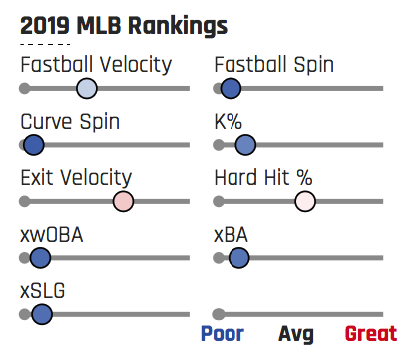
Wacha is still a back-of-the-rotation starter who fared very well in this game with a mixture of poor opponent, opportunistic defense and some veteran moxie. Throughout the season, starts like this happen from #4/#5 starters, but the randomness of them makes predicting one a fool’s errand.
Fanalytic Storyline #2: Alcantara, searching for consistency
Sandy Alcantara (RHP, MIA) had an up-and-down first full season for the Marlins—not out of the ordinary with any talented rookie pitcher—and in this game, one can see both flashes of intrigue and inconsistency that warrants keeping an eye on this slim, 24-year-old flamethrower.
First, the good news: he pumps the heat, has a diverse arsenal, and his stuff moves. With an overall average FB velocity of 95.6, Alcantara reached back for 98 on one four-seamer; and was 94-96 on his sinker, with a 22% SwK rate. He also incorporated a slider and change-up regularly with varying results; using the SL as his primary secondary pitch early, and leaning on the CH later in the game. Plus, the arm-side movement on both his sinker and change-up were especially notable, and at his best, he used them to bust RHH inside and tail pitches away from LHH. Here’s a Statcast visual of his 2019 arsenal with regards to pitch movement (catcher's viewpoint). We're especially interested in horizontal movement (pitches furthest from the centerline):
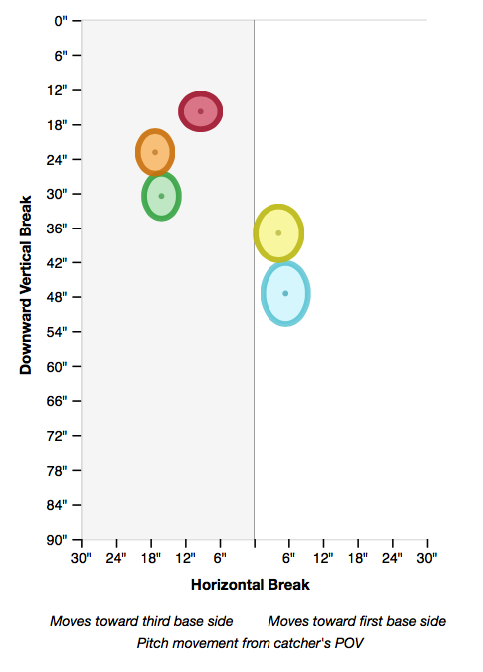
Key: Red/fourseamer; Orange/sinker; Green/change-up; Yellow/slider; Blue/curve
Though this tracks both vertical and horizontal break, note the excellent horizontal movement on the sinker and change.
Second, the work-in-progress: In this, just his 19th MLB start, he’s still learning how to provide an inning-by-inning consistency necessary to succeed at this level. We get hints of this in his pitches-by-inning log for this game: 14 / 27 / 12 / 22 / 9 / 12 (taken out after facing 3 batters in the 6th). He blew through three up/three down batters in the odd-numbered innings, but struggled in innings 2, 4 and 6.
This was reflected in his pitch selection, also—as noted above, he threw a lot of sliders in the dirt early in the game; the pitch had a decent break but he couldn’t locate it for strikes consistently. Once he realized that his change-up was working well, that became his primary offspeed offering. The were flashes where both pitches were working—that he could drop the SL in for strikes and also use the change gave an indication of how tough he could be when things came together.
Third, there’s some definite hope for the future here, looking back on his season from this vantage point. Some of his difficulty in this viewing occurred when he was ahead in the count and was unable to put hitters away. Often, it seemed like he and catcher Jorge Alfaro tried to go up the ladder to (understandably) to attempt to get a swing-and-miss on the high-90s heat. But many times, Alcantara missed way up and out of the zone—sure it was 96/97, but no where near the location that would cause a hitter to chase. Indeed, that characteristic had a hand in the four walks he issued. His inability to control that pitch caused some of the long innings, and a Ctl rate that has been historically problematic was in in full view.
But in the Baseball Forecaster, we (and others) mentioned how Alcantara’s second half featured better control and improved overall numbers. And looking back on his season-long pitch mix, we get to an “a-ha” moment:
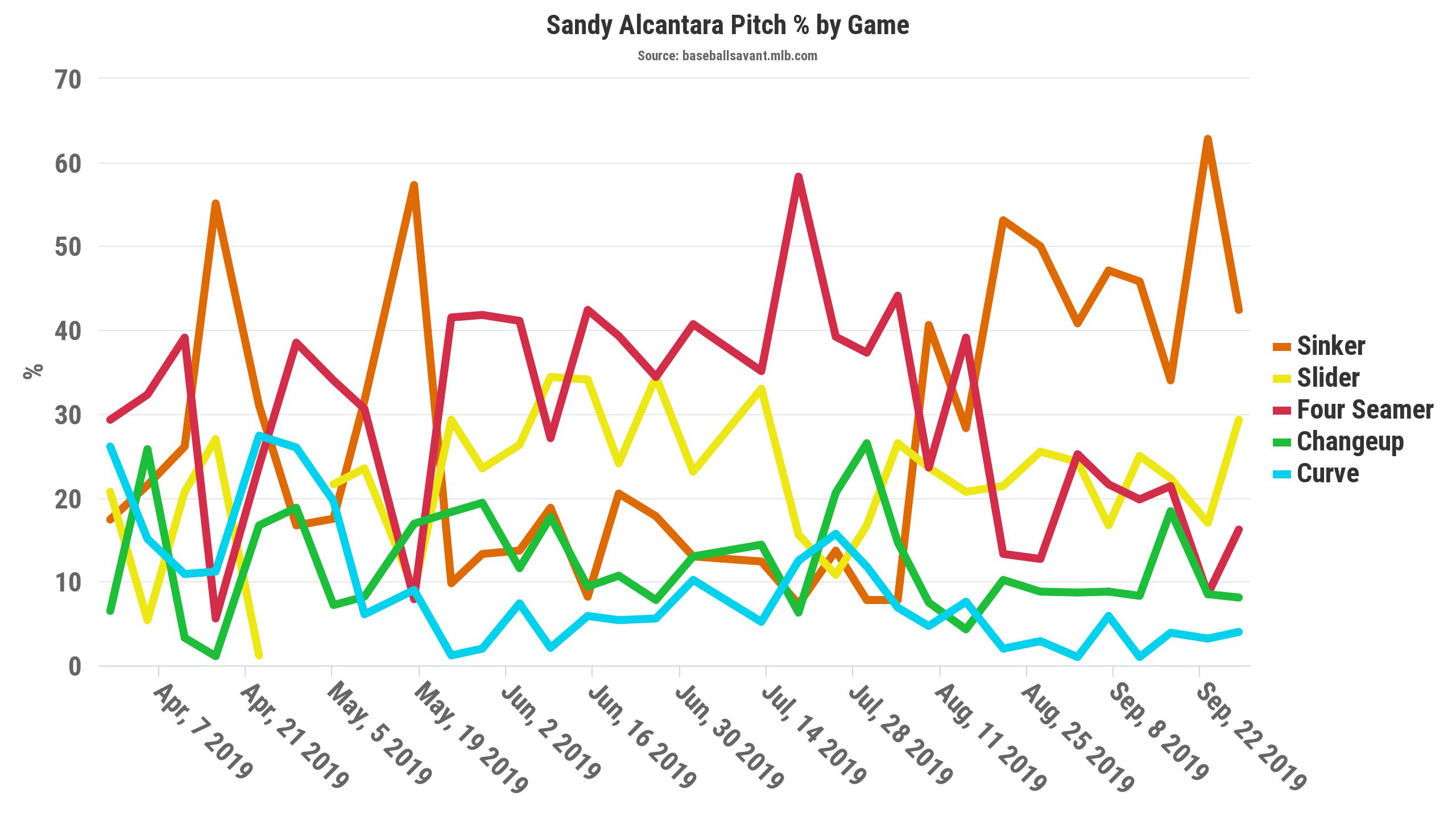
Starting in the beginning of August, he began using his sinker more, and four-seamer less. And in the August 22 start, he more or less flipped his usage patterns on the two fastballs (indicated but the red and orange points lines crossing). It would seem to reason, given what we see in this June start, that he is able to control his sinker much better than his four-seamer. So in turn, by that throwing more sinkers and less four-seamers later in the year, it follows that his September K/BB numbers of 35/9 could be a whiff of things to come.
Of course, that’s not the lone key here, but if he’s able to build on that success in 2020 and beyond, his arsenal and acumen could take a step forward in the near future.
Fanalytic Storyline #3: Alfaro: Tools, unbridled
Another Statcast dashboard on Jorge Alfaro (C, MIA):
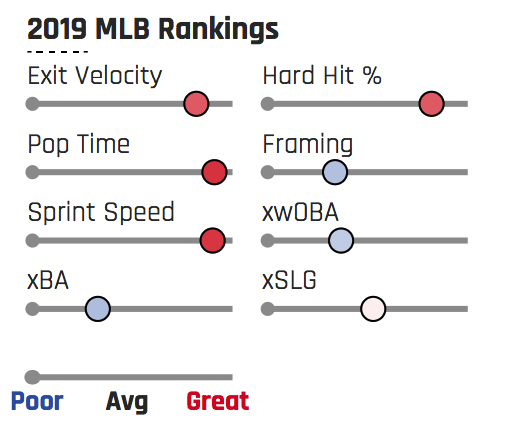
This is what keeps me (probably overly) optimistic in Alfaro from a fantasy perspective: He hits the ball friggin’ HARD. And it just so happens that for this game, he delivered in spades on that very topic. His at bats, in order:
- Third inning: hard single to left, exit velocity 109.1 mph
- Fifth inning: hard single to right, exit velocity 109.8 mph
- Seventh inning: ground out to second (RBI); exit velocity 111.6 mph
Alfaro accounted for three of four highest exit velocities in the game, and it wasn’t an aberration: his 2019 seasonal exit velocity was 90.8, down a smidge from 2018’s 91.7. (The league average in 2019 was 87.5.) His max exit velocity in 2019 was 114.7 (29th in MLB); his 11.5 barrel % was also much higher than the MLB average of 6.3.
The sticking point, of course, is Alfaro’s awful contact rate (64%) and undisciplined approach (5% bb%, and a bevy of bottom-tier Statcast swing metrics such as Chase %). He hits the ball very hard, but doesn’t make contact enough.
But exit velocity is not the only impressive raw tool that had an impact on this game. As noted above, Alfaro is a 90th-percentile baserunner according to sprint speed. But in this game, perhaps that had a negative outcome for the team. After leading off the bottom of the third inning with a single, Miguel Rojas walked on four pitches, giving the Marlins two on and nobody out with pitcher Alcantara at the plate. It was an obvious bunt situation with no score in the game so far. But Alfaro, in scoring position, got picked off second base by Wacha for the inning’s first out, and effectively shut down the Marlins' chances for scoring that inning. Whether it was simply getting too big of a lead, or falling asleep out there, the Alfaro pick-off played a big role in what could have been a big inning.
Later, with the Cards up just 1-0 in the sixth, Alfaro made a defensive miscue that really put the game away. All through the minors and now in his young MLB career, Aflaro has shown ability to defend bunts and squib hits with aplomb. Quick reflexes, uncanny athleticism, and a cannon arm combine where we’ve seen him convert these softly hit in-front-the-plate tappers into outs. But with two runners on, and Kolten Wong at the plate, Alfaro got out quickly to field a bunt towards the third base line, spun towards first and fired. The throw would have beaten the well-running Wong easily, but it was a bit high and to the second-base side. The ball only nicked Garrett Cooper’s glove and took off down the right-field line. Both runners on base scored; Wong ended up at third and eventually became the fourth Cardinal run. Alfaro in this case trusted his arm—one of the very things that could have converted the play into an out—and it failed him.
It’s certainly tough to try and expect young players with such outstanding tools like these to play a bit more controlled. It’s these flashes—when they work—that gets baseball fans and fantasy owners excited about what could be. If Alfaro made some better contact (and found a way to hit the ball in the air more). If he played a headier game on the bases, or dialed it back enough to assure a throw was accurate. Meanwhile, we hope for the maturation that may or may not come.
Fanalytic Storyline #4: Appreciating (and missing) Jordan Hicks
As mentioned above, Jordan Hicks (RHP, STL) entered in the 9th to close out the win for the Cards. This was his next-to-last save of 2020, as he succumbed to an elbow injury later that month and subsequently had Tommy John surgery.
In watching this outing, we’re reminded of not only the consistent triple-digit fastball—he threw eight of them here, all 101 or 102 mph—but of two critical sub-points that make his arsenal special.
First, the incredible movement that his 102 mph sinker has. This pitch is not straight, as the graphic from this evening reminds us:
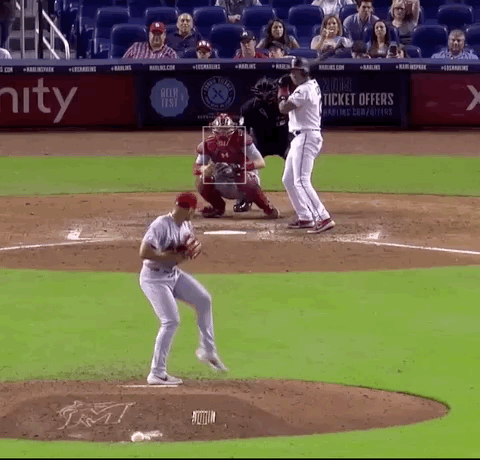
Second, his off-speed offering—a tight SL that dives away from a right handed hitter—comes in at 86-87. For most pitchers, that is often the velocity range of a very good slider—only for most pitchers, especially FB/SL relief aces—it’s playing off a mid-90s fastball. Here, the pitch is a full 15 mph slower than Hicks’ fastball. That is optimum velocity separation for a two-pitch guy, and doesn’t event take into account that the hitter has to be geared up and ready 102.
And I fully realize that this info is nothing new, but it’s something that stood out as I watched Hicks do his thing in the 9th and knew it will likely be 2021 until he attempts it again. Get well, Jordan.





-300x200.png)


